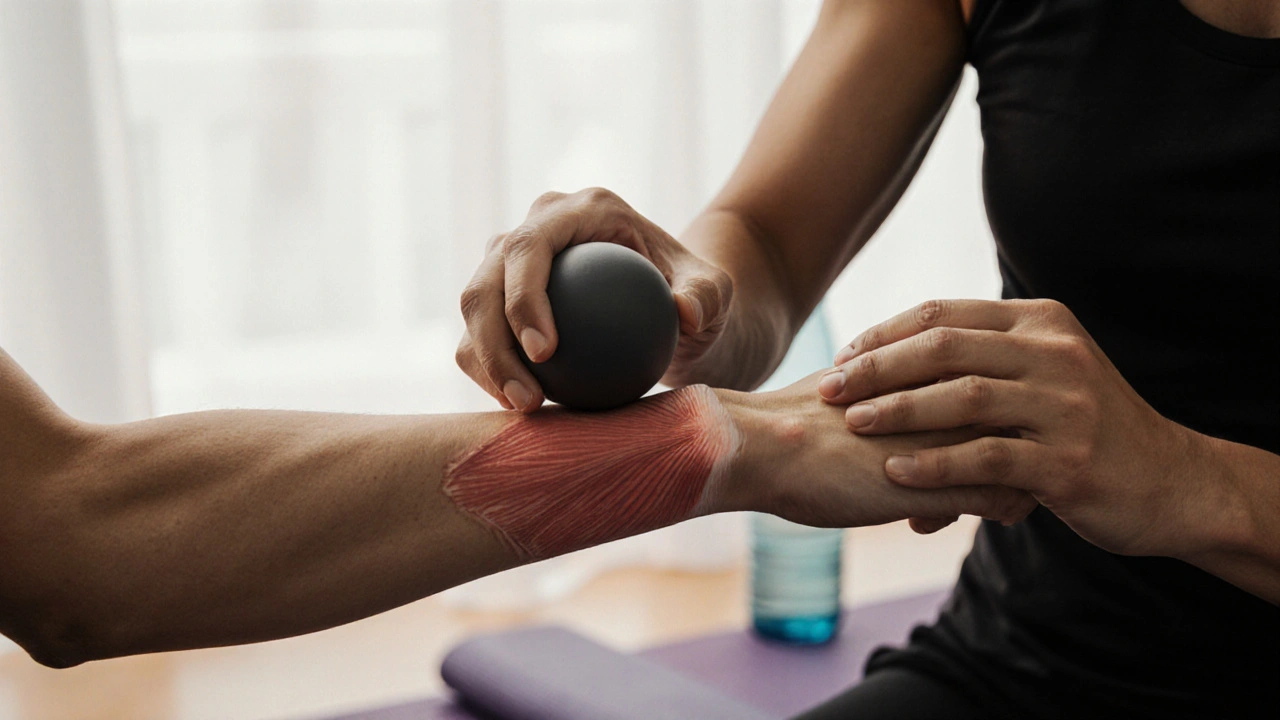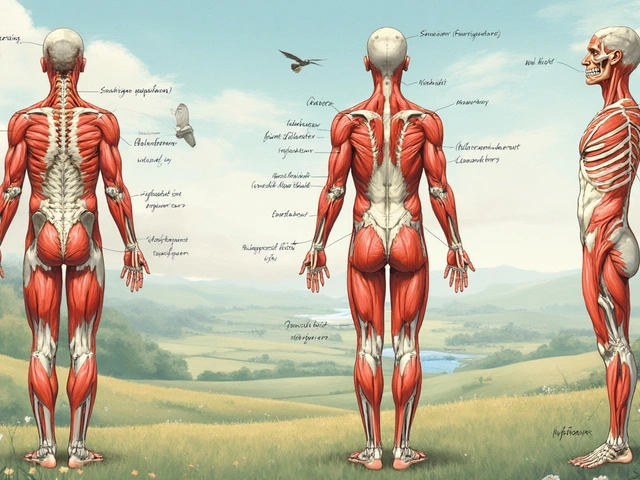Boost Your Recovery Process with Cross Fibre Release

Cross Fibre Pressure Guide
Find Your Safe Pressure Level
Cross fibre release requires precise pressure - too little and it won't work, too much and you could cause damage. This calculator helps you find the right level for your specific situation.
Recommended Pressure Level
For the best results:
- Apply firm pressure, but not to the point of sharp pain
- Hold for 20-30 seconds before moving to a new spot
- Stop immediately if you feel tingling or numbness
- Repeat for 2-3 minutes per area, once daily
If you’ve ever pushed through a tough workout only to feel stiff, sore, or stuck for days afterward, you’re not alone. Most people assume rest and ice are enough to get back on track. But if your muscles still feel tight, knotted, or painful after a few days, you might be missing a key piece of the puzzle: cross fibre release.
What Is Cross Fibre Release?
Cross fibre release is a manual therapy technique used to break up scar tissue and adhesions in muscles, tendons, and fascia. Unlike regular massage that follows the direction of muscle fibres, cross fibre release moves perpendicular to them-like combing tangled hair sideways instead of along its length.
This method targets areas where tissue has become stiff or stuck due to injury, overuse, or repetitive motion. Think of it as gently peeling apart layers of glue that have formed between muscle fibres after trauma. When done correctly, it restores movement, reduces pain, and speeds up healing.
It’s not new-physical therapists and sports clinicians have used it for decades. But now, more athletes, fitness enthusiasts, and even office workers are discovering how powerful it can be for recovery.
Why It Works Better Than Regular Massage
Regular massage feels good because it relaxes the nervous system and increases blood flow. That’s helpful. But if you’ve got real scar tissue or adhesions-like from a pulled hamstring, chronic tennis elbow, or even a past surgery-gliding over the surface won’t fix the problem.
Cross fibre release works differently. It applies focused pressure across the grain of the tissue. This creates micro-tears in the abnormal collagen fibers that have formed during healing. In response, your body sends in fresh cells to rebuild the area properly, aligning new fibres in a more functional, flexible pattern.
A 2023 study in the Journal of Sports Rehabilitation tracked 68 athletes with chronic calf tightness. Half received traditional massage; the other half got cross fibre release. After four weeks, the cross fibre group showed 42% more improvement in range of motion and 31% less pain during activity.
When Should You Use It?
This technique isn’t for every kind of pain. Here’s when it helps:
- Chronic muscle tightness that doesn’t improve with stretching
- Tendinitis (like Achilles, rotator cuff, or golfer’s elbow)
- Post-injury stiffness after sprains or strains
- Fascial restrictions (think plantar fasciitis or IT band syndrome)
- Scar tissue from old surgeries or deep cuts
It’s not for acute injuries. If your muscle is swollen, red, or burning hot, wait a few days. Cross fibre release is for the healing phase-after the inflammation has settled but before stiffness sets in.

How to Do Cross Fibre Release Yourself
You don’t need a professional to get results. With the right technique, you can do this at home with a foam roller, lacrosse ball, or even your fingers.
Here’s how:
- Find the tender spot. Press around the area until you find a knot or tight band that feels like a cable under your skin.
- Apply firm pressure-enough to feel discomfort but not sharp pain. Think 5-7 out of 10 on the pain scale.
- Move your fingers, ball, or roller perpendicular to the direction of the muscle. For example, if your quads run up and down, move side to side.
- Hold pressure for 20-30 seconds, then slowly move 1 inch in any direction and repeat.
- Do this for 2-3 minutes per area, once a day.
Don’t rush it. This isn’t about brute force. It’s about precision. One minute of focused work on a tight spot is better than five minutes of random rubbing.
Common Mistakes to Avoid
People often mess this up in three ways:
- Using too much pressure-You’re not trying to bruise yourself. If it hurts so bad you flinch, ease up. You’re breaking down scar tissue, not causing more damage.
- Moving in the wrong direction-If you’re going with the muscle instead of across it, you’re just massaging. That won’t fix adhesions.
- Doing it too often-Once daily is enough. Twice a day can irritate the tissue. Let your body rebuild overnight.
Also, avoid doing this right before a heavy workout. It’s a recovery tool, not a warm-up. Do it after exercise, or on rest days.

Pair It With Other Recovery Tools
Cross fibre release works best when combined with other habits:
- Hydration-Tissue needs water to stay pliable. Drink at least 2 liters a day.
- Light movement-After releasing a knot, walk for 10 minutes. Movement helps the new tissue align properly.
- Heat before, ice after-Warm the area with a heating pad for 10 minutes before releasing. If you feel any swelling afterward, apply ice for 15 minutes.
- Stretching-Wait 30 minutes after cross fibre release, then gently stretch the area. Don’t force it.
One runner I worked with had plantar fasciitis for 14 months. She tried orthotics, night splints, and ultrasound therapy. Nothing stuck. Then she started doing cross fibre release on her arch with a golf ball every morning, followed by a short walk. Within three weeks, her pain dropped by 80%. She’s been running again for six months.
When to See a Professional
You can do a lot on your own. But if you’ve tried cross fibre release for two weeks with no change-or if your pain is getting worse-it’s time to see someone trained.
A licensed massage therapist, physical therapist, or sports medicine specialist can use deeper, more precise techniques. They can also tell you if your pain is coming from something else, like a nerve issue or joint dysfunction.
Don’t wait until you’re sidelined. If you’re still limping, avoiding movement, or taking painkillers just to get through the day, get help.
Real Results, Real Time
People think recovery means waiting. But recovery is active. It’s not just resting-it’s rebuilding.
Cross fibre release gives you control. You don’t need expensive gear, long appointments, or complicated routines. Just your hands, a ball, and a few minutes a day.
It’s not magic. But it’s science. And for people tired of feeling stuck, it’s often the missing piece they didn’t know they needed.
Can cross fibre release help with old injuries?
Yes. Even injuries from years ago can benefit. Scar tissue doesn’t disappear on its own-it just gets harder. Cross fibre release can break down those old adhesions and restore flexibility. Many people report improved movement after treating chronic issues like old ankle sprains or shoulder surgeries.
Is cross fibre release the same as foam rolling?
Not exactly. Foam rolling is great for general muscle relaxation and blood flow, but it usually moves along the muscle, not across it. Cross fibre release requires deliberate, perpendicular motion to target adhesions. You can use a foam roller for cross fibre work, but a small ball or your fingers gives you more control and precision.
How long does it take to see results?
Some people feel looser after one session. For lasting change, especially with chronic issues, plan for 2-4 weeks of consistent daily work. Improvement comes gradually-like peeling an onion. Each layer you release makes the next one easier to reach.
Can I do cross fibre release on my neck?
Yes, but be careful. The neck has sensitive structures like nerves and blood vessels. Use very light pressure-just enough to feel tension. Stick to the sides of the neck, avoiding the front and spine. If you’re unsure, start with a soft ball and let your body guide you. If you feel tingling, numbness, or dizziness, stop immediately.
Does cross fibre release hurt?
It should feel like a deep, uncomfortable pressure-not sharp or burning. Think of it as a "good hurt," like stretching a tight muscle. If it feels like a stabbing pain or radiates down your arm or leg, you’re pressing on a nerve or too much tissue. Back off. The goal is to release, not to injure.
Recovery isn’t about waiting for time to heal you. It’s about working with your body to rebuild stronger, smarter, and more resilient. Cross fibre release gives you that power-right in your own hands.





